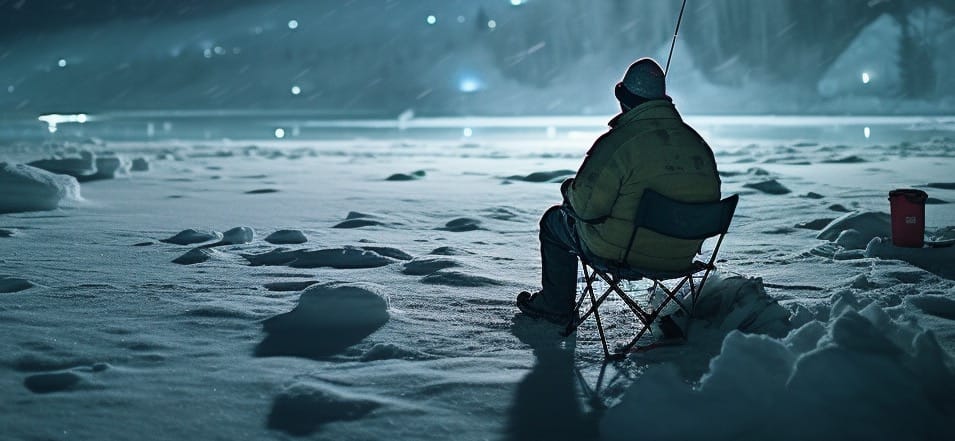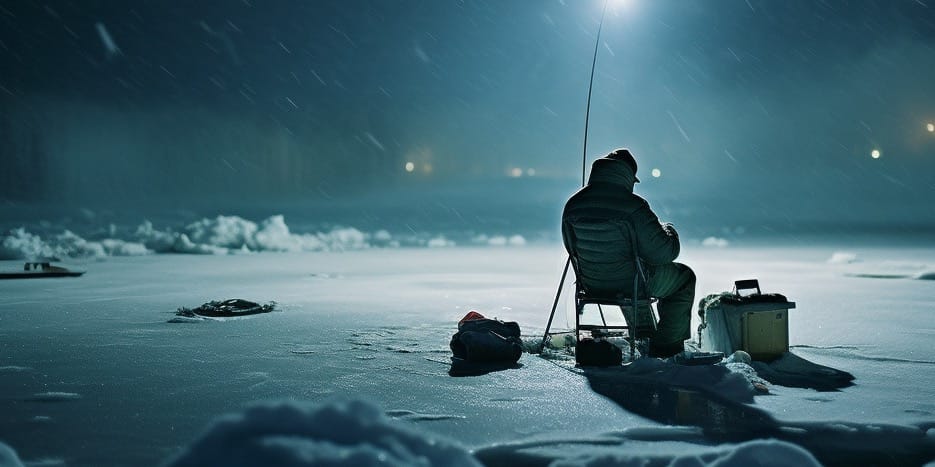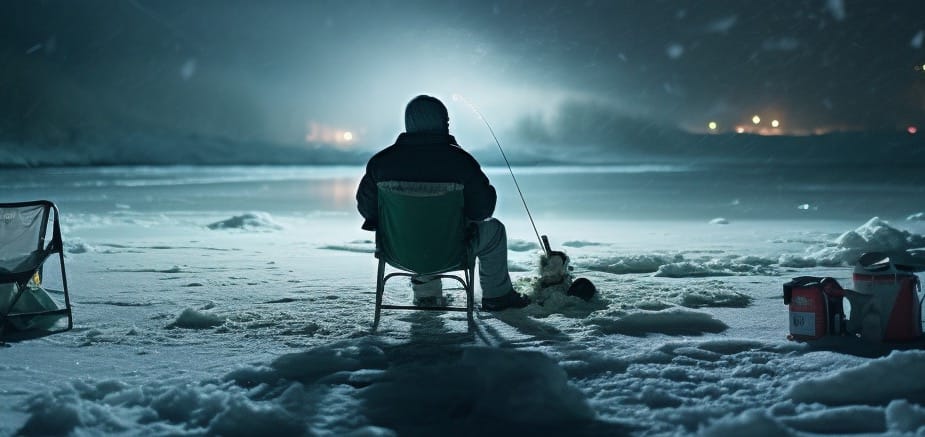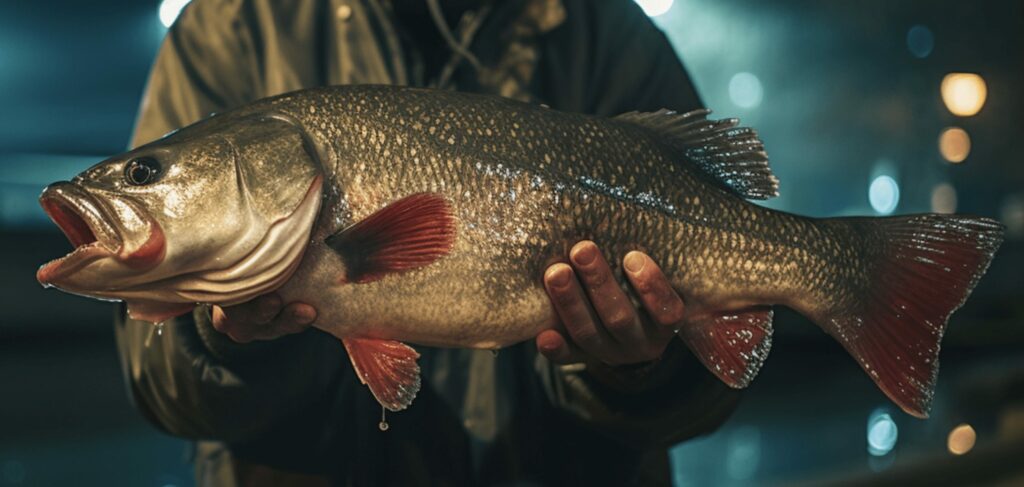We already talked about night fishing for crappie, but what about ice fishing for crappie at night?
In the realm of fishing, icy waters present their own set of challenges and opportunities. Trust me, I’ve been there, freezing my fingers off while trying to reel in a catch. Knowing what you’re doing is not just an advantage; it’s essential.
This is especially true when you’re out there in the dead of night, ice fishing for crappie.
Now, I get it. The internet is a maze of articles, how-to guides, and an endless stream of “expert advice.” You could spend hours scrolling and still end up confused. That’s precisely why I crafted this guide.
I’ve waded through the misinformation, tested the waters—literally—and I’m here to give you the real deal.
Consider this article your ultimate resource, your bible if you will, for mastering the art of ice fishing for crappie at night.
So, let’s get started, shall we?
Understanding Crappie Behavior At Night

When ice fishing for crappie not just out there to freeze your toes off; you’re there to catch some crappie.
And let me tell you, understanding these fish is half the battle.
First off, crappie are night owls—just like some of us who enjoy the peace and quiet of a late-night fishing trip. During the winter months, particularly January and February, these fish go full nocturnal.
They’re out there in the dark, munching on minnows and insect larvae.
So, if you’re planning to catch them, you better adjust your body clock to their feeding time.
Know Where to Drill
Now, you can’t just drill a hole anywhere and expect the fish to come to you. You need to know the lake like the back of your hand.
I always make it a point to chat with local bait and tackle shops. You’d be amazed at the goldmine of information these folks have.
Pro Tip: Before the lake turns into a frozen wonderland, mark your hotspots on your fish finder. These are usually around submerged trees, rocky points near weed beds, and channels. Once the lake is frozen, go back to these spots.
Tips for Ice Fishing For Crappie At Night
Here are some tips I can share with you to maximize your catch when ice fishing for crappie at night.

Why Nighttime is Prime Time
Crappie are most active during the late hours, especially in the dead of winter. It’s like they’ve got their own nightlife going on underwater.
I’ve found that the action really picks up a couple of hours after sunset, right when the underwater world is buzzing with activity.
So, if you’re planning to hit the ice, aim for those late-night hours. The crappie are out and about, and they’re hungry.
Timing is Everything
Listen, I’ve been out on the ice at all hours, and I can tell you that timing isn’t just a suggestion; it’s a rule. Crappie are most active during dawn and dusk.
I’ve had my best catches just as the sun dips below the horizon. It’s like the crappie have an internal alarm clock that goes off, signaling feeding time.
So, if you’re planning a night out on the ice, align your schedule with theirs. You won’t regret it.
The Right Jig Can Make All the Difference
I’ve experimented with a myriad of jigs, and let me tell you, not all jigs are created equal.
Bright colors like chartreuse, especially when paired with an orange or green jig head, have been my go-to. It’s like crappie candy; they just can’t resist it.
Keep Moving to Find Active Fish
I’ve had days where I felt like a nomad, drilling hole after hole just to find the crappie. And you know what? It’s worth it.
Crappie are notorious for their winter wanderlust. They move around a lot, following oxygen levels and bait.
Use a flasher to locate them, and if you’re not getting any action, don’t hesitate to move.
In fact, I’d go as far as to saying that staying mobile is the key to a full bucket.
Mimic the Plankton
When it comes to ice fishing, the idea of mimicking plankton might sound a bit out there, but it’s all about understanding the food chain. Plankton attracts smaller fish, which in turn attract crappie. While you can’t exactly replicate a microscopic organism, you can mimic its movement to fool crappie into thinking they’re going for their favorite snack.
Here’s how it works in the context of ice fishing:
- Tungsten Jig and Soft Plastic Tail: The tungsten jig sinks faster and gives you better control. A soft plastic tail adds the necessary movement. When jigged properly, it can simulate the erratic, floaty movement of plankton.
- Working the Water Column: Crappie aren’t always at the bottom. They can be suspended at different depths, usually where there’s a high concentration of plankton. By working a 1-2 foot section of the water column, you’re more likely to pass through the crappie’s line of sight.
- Light, Rhythmic Pulsing and Pausing: This is where the “dance” comes in. Plankton doesn’t swim in a straight line; it floats and drifts. Light, rhythmic pulsing and pausing with your rod tip can make your jig imitate this movement. It’s this action that piques the crappie’s interest and triggers bites.
Use a Glow Stick or Underwater Light
Now, this is where technology gives us the upper hand. A glow stick or an underwater light can be a game-changer. It’s like throwing a party underwater for plankton, and guess who’s coming to dinner? That’s right, crappie. Just make sure you’re up-to-date with local regulations. The last thing you want is to get slapped with a fine.
Drilling Patterns for Success

You’ve got your spot, you’ve got your gear, but how do you actually go about making those holes in the ice? It’s not as simple as just drilling willy-nilly.
There’s a method to the madness, and I’m going to break it down for you:
The Straight-Line Fallacy
You might be tempted to just walk in a straight line, drilling holes every 10 feet or so. I mean, it’s the straightforward approach, right? Wrong. I’ve tried this method, and let me tell you, it’s a waste of time and energy. You’re basically setting yourself up for a long, cold night of disappointment.
Plus, when you’re out there in the dark, that last hole you drilled becomes a forgotten relic. You’re not going to trek back and forth in the cold to check it, and you know it.
So, just make sure to avoid the straight-line trap. It’s not efficient, and it’s not smart.
You’re better off focusing on a more strategic drilling pattern that keeps you close to all your holes, making it easier to manage your lines and maximize your chances of a good catch.
Circular or Star Pattern: The Smart Way
Now, here’s my go-to strategy:
I pick a central location, usually a spot where I’ve had success during the open-water season. Then, I drill holes in a circular or star pattern around that point.
Why?
Because it keeps me close to all my holes, making it easier to monitor each one. I keep the radius less than 10 yards so I can quickly move from hole to hole without breaking a sweat.
Varying Depths: Don’t Put All Your Eggs in One Basket
Crappie are unpredictable, especially when it comes to their preferred depth.
I mean, one minute they’re near the surface, the next they’re hugging the bottom.
So, I hedge my bets. I drill holes at different depths—some in shallower water, some in deeper zones.
This way, if I notice the crappie are favoring a particular depth, I can quickly switch my setup.
Technology is Your Friend: Using Fish Finders
If you’re new to a lake, or even if you’re a seasoned pro, technology can give you a serious edge. I’m talking about fish finders that can scan through the ice.
Just place it on the ice, and boom, you’ve got a window into the underwater world. It can show you where the crappie are hanging out, saving you the guesswork and the drilling time.
Bait Placement
Once my holes are drilled and I’m ready to fish, I don’t just throw the same bait into each hole. That’s like ordering the same dish at a buffet; you’re missing out on variety.
Some holes get live minnows, others get waxworms or jigs. Then, it’s a matter of observation.
If the crappie are hitting the minnows hard, I switch all my setups to minnows. It’s like tuning into the crappie’s wavelength and giving them what they want.
The Role of Lights in Night Fishing
Alright, you’ve got your holes, your bait, and a strategy.
But what about lighting?
Trust me, when the sun goes down, lighting is going to be your best friend.
The Lure of Luminescence: Why Light Matters
Let’s get one thing straight: light is your best friend when you’re out on the ice at night.
I’ve been in situations where I thought I could get by with just the moonlight or my phone’s flashlight. Big mistake.
Light not only helps you see what you’re doing but also attracts plankton, which in turn attracts crappie.
Types of Lights: From Glow Sticks to LED Lanterns
When it comes to lighting up your icy fishing spot, you’ve got more options than a kid in a candy store. Trust me, I’ve been through the gamut, and each type of light has its pros and cons. Let’s break it down.
- Glow stick: These are your quick and dirty solution. Just crack one open, give it a shake, and you’ve got instant light. They’re portable, they’re cheap, and they don’t require any batteries. Sounds perfect, right? Well, not so fast. The downside is that they don’t last very long, maybe a couple of hours at best. Plus, the light intensity isn’t that great, so they’re not ideal for attracting fish.
- LED lanterns: These are like the Swiss Army knives of fishing lights. They’re versatile, offering adjustable brightness levels, and some even come with different color options. The downside? They can be a bit much. I mean, you’re fishing, not filming a Hollywood movie. Plus, they can be bulky and you’ll need to make sure you’ve got enough battery power to last the night.
- Submersible fishing lights; These are the game-changers, my friends. These lights are designed to go directly into the water, and they attract fish like you wouldn’t believe. They usually come in green or blue, colors that penetrate the water well and attract plankton, which in turn attracts crappie. It’s like setting up a dinner bell for the fish. The only downside? They can be a bit pricey, but in my opinion, they’re worth every penny.
The Color Spectrum: What Crappie Can See
You might be wondering, “Do crappie even see color?” The answer is yes, but not like we do.
I’ve found that green and blue lights tend to work best as these colors penetrate the water better and seem to attract more crappie.
Placement and Depth: Where to Put Your Lights
I’ve spent countless nights on the ice tweaking my setup, and I’ve found that the sweet spot for light placement is about 2-3 feet below the ice surface.
Why?
Well, because this depth seems to be the perfect zone for attracting plankton, which as you know, is the first step in luring in those crappie.
Now, you might be wondering why I don’t go deeper. Well, I’ve tried that, and it doesn’t seem to have the same effect. Go too deep, and you’re not attracting the plankton that stays closer to the surface. Go too shallow, and you risk scaring away the crappie with too much light. It’s a delicate balance, and that 2-3 foot range seems to hit the mark.
But hey, don’t just take my word for it. Experimentation is key.
Try setting up lights at different depths and monitor the results. You might find that your local crappie population has different preferences. Maybe they like it a bit deeper, or perhaps they’re surface feeders. The point is, don’t be afraid to mix it up and test different depths. After all, fishing is as much about learning and adapting as it is about the catch itself.
Don’t Forget the Basics: Safety First
Lastly, let’s talk safety.
Always make sure your lights are securely fastened and not causing any glare that could be a hazard. The last thing you want is to trip over your gear in the dark. And remember, you’re dealing with electricity near water, so take the necessary precautions.
Bait and Jigging Techniques
Live vs. Artificial Bait Options
Look, I get it. You’re out there on the ice, it’s dark, and you’re wondering what the heck to put on the end of your line.
Well, let me break it down for you:
Live bait is a crappie’s dream dinner. Minnows, wax worms, you name it.
But here’s the kicker—artificial bait can work just as well if you know what you’re doing. Glow jigs are a game-changer; they light up like a Christmas tree underwater, attracting crappie like moths to a flame.
So, whether you’re a purist or just forgot to stop by the bait shop, you’ve got options.
Jigging Techniques to Mimic Plankton
You ever watch plankton? Probably not, but crappie do. They love the stuff.
Your jigging technique should mimic the movement of plankton, which is basically a slow, upward pull followed by a quick drop.
This erratic movement drives crappie wild. Trust me, I’ve seen it.
You can also use your fish finder to locate where the crappie are and adjust your jigging depth accordingly.
Keeping Crappie Active
Now, you might think that crappie are just lazy fish waiting for food to come to them. Wrong.
These fish are hunters, especially at night.
To keep them active and interested, switch up your bait and jigging techniques. If you’ve been using minnows and not getting bites, switch to wax worms or even artificial lures. Keep them guessing, and you’ll keep them biting.
The Role of Technology
Don’t underestimate the power of technology when you’re out on the ice.
Fish finders aren’t just for open water; they’re invaluable for ice fishing too.
These gadgets can show you in real-time where the crappie are hanging out, allowing you to adjust your bait and jigging technique on the fly. It’s like having X-ray vision, but for fishing.
Frequently Asked Questions
1) What is the best bait for crappie at night?
Listen, if you’re going to be out there in the cold, you might as well use bait that works, right? The best bait for crappie at night is live minnows. These little guys are like crappie candy. But if you’re looking for an alternative, glow jigs paired with chartreuse wax worms are a killer combo.
2) What is the best bait for night ice fishing?
Night ice fishing isn’t just about crappie; you might catch other species too. So, if you’re looking to diversify your catch, consider using a variety of baits. Live minnows are always a good choice, but don’t underestimate the power of artificial lures like glow jigs and soft plastics.
3) What is the best color for ice fishing?
Color matters, especially when you’re fishing in low-light conditions. Bright colors like chartreuse, orange, and even white can be highly effective. These colors stand out in the dark and are more likely to attract crappie and other fish.





